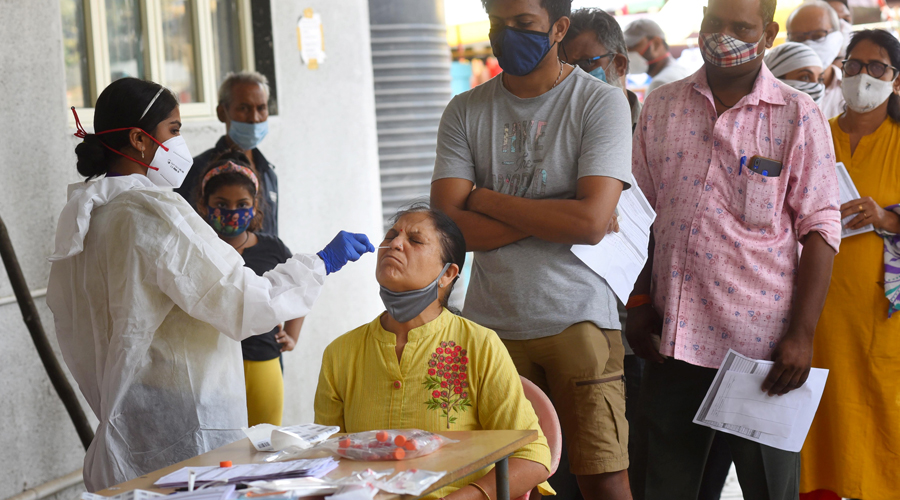A veteran public health expert warned top Indian officials in early March that a new variant of the coronavirus was spreading quickly in a rural district in Maharashtra and that the outbreak required urgent attention.
Federal health authorities failed to respond adequately to that warning, Dr Subhash Salunke, who has 30 years of experience in public health in India, Indonesia and the US, told Reuters.
The variant, now known as B.1.617, triggered a catastrophic wave of coronavirus cases in India and has since spread to more than 40 other countries. In May, the World Health Organisation (WHO) termed it a “variant of concern”, citing its high transmissibility.
Salunke, a former WHO official advising the Maharashtra government, said he alerted some of India’s most senior health officials in early March, speaking on the telephone to Prime Minister Narendra Modi’s main coronavirus adviser, V.K. Paul, and the head of the National Centre for Disease Control (NCDC), Sujeet Kumar Singh.
In response to Reuters’ questions, Paul said he had spoken with Salunke but described the conversation as Salunke conveying information rather than issuing a warning.
The variant’s first impact had been detected months earlier in Maharashtra’s Amravati district, where health authorities recorded a rapid increase in coronavirus infections in early February, even as cases fell elsewhere in India.
Salunke told Reuters he had warned both Paul and Singh that the virus was showing signs of mutating in Amravati, that its transmissibility was increasing, and requested federal help in sequencing more samples to establish how the variant was behaving. Reuters could not independently confirm what was said in those conversations.
“In spite of a public health person like me giving them a sound warning, they did not take heed,” Salunke told Reuters.
Paul rejected Salunke’s accusation that he did not take heed, saying he had requested that India’s National Institute of Virology (NIV) study the variant more closely, and told the Maharashtra government to intensify its existing response to the virus.
Reuters could not determine if the NIV carried out any such study. The NIV directed Reuters’ questions to the Indian Council of Medical Research (ICMR), which did not respond.
The government strengthened the sequencing and clinico-epidemiological studies, Paul told Reuters. The government intensely, repeatedly, from multiple fora, emphasised the need for containment using all the tools even more vigorously and optimising testing.
The NCDC’s Singh and the Union health ministry did not respond to questions from Reuters about Salunke’s warning.
Despite Salunke’s flagging of the problem, and a further warning in early March from a forum of scientific advisers that the new variant was taking hold in the country, the central government allowed election rallies, religious festivals and other mass gatherings to proceed, and failed to take measures to halt the spread of the virus.
Within 80 days, the variant went from Amravati to dozens of countries around the world, including the UK, US and Singapore, presenting a setback to global efforts to contain the disease.
It is impossible to say exactly how many infections in each country have been caused by the new variant, because very few samples from positive tests have been sequenced. US authorities estimated last week that the variant accounted for 6 per cent of coronavirus infections there.
In India, the dramatic rise in infection numbers from April onwards — partly driven by the variant, according to public health studies — overwhelmed the country’s health system, causing hospitals to run out of beds and oxygen and causing crematoriums and graveyards to overflow.
India’s health minister, Harsh Vardhan, said last month that the variant had been identified in about 20 per cent of samples in the country that had been sequenced.
In late January, when India’s daily count of coronavirus infections had fallen to around 12,000, Modi had all but declared victory at a World Economic Forum event, saying the country had “saved humanity from a big disaster by containing coronavirus effectively”.
That sense of optimism was sweeping large parts of India, including Amravati, where cases had dropped to a trickle, according to local health officials. The district, home to 2.9 million people, had reported only dozens of Covid-19 cases daily through much of January, according to government data.
“Everyone was relaxed,” said Shyamsunder Nikam, Amravati’s civil surgeon, who supervises public health matters in the district.
But case numbers started suddenly rising in late January, alarming Nikam and other local officials. New infections rose to around 200 a day by February 7 and reached 430 a day a week later, as the virus tore through the district’s rural interior that had been largely unscathed during India’s first wave in 2020.
A task force set up by the Maharashtra government to guide its pandemic response ordered a probe. Dr Rajesh Karyakarte, who was part of the investigation, said he analysed four positive samples from the region and found they all contained a mutation called E484Q, a sign that a variant was likely at play.
Karyakarte told Reuters he had presented the findings to the Maharashtra task force in a videoconference on February 16. Reuters could not independently confirm if he had done so or how the task force responded. Dr Tatyarao Lahane, a member of the task force, did not respond to questions from Reuters.
The discovery of the new mutation and spiking case numbers in Amravati alarmed Salunke. He said he travelled to Amravati in late February and conducted coronavirus tests on nearly 700 people. Around half of them turned out positive for Covid-19.
Within a few days, he told Reuters, state health authorities sent samples from Amravati to the NCDC for further genetic sequencing to establish if a variant was present. The NCDC did not respond to questions from Reuters about what it did with those samples.
Meanwhile, Union health officials played down the potential role of new variants in the spike of infections.
“There is no direct relation between the recent surge in Covid-19 cases in Maharashtra and some other states with the mutant virus strains N440K and E484Q of Covid-19,” India’s health ministry said in a media statement on February 23.
According to Modi’s coronavirus adviser Paul, that assessment had been based on the data authorities had at the time.
“We knew that something had been spotted but we didn’t know the significance thereof at that point,” Paul told Reuters. “The true significance of variants emerges with time. Scientific data has now led us to understand the role of these variants.”
In late February, central and local officials had a meeting to discuss the spike in Amravati, according to a senior government scientist who attended it.
At the meeting, Maharashtra’s state surveillance officer, Dr Pradip Awate, said the rise in cases owed to voters flocking to local elections held in January rather than any kind of new variant, the scientist who attended the meeting told Reuters.
Central officials, including some from the Indian Council of Medical Research, appeared convinced by that explanation and did not press for further investigation, the scientist said.
“At that time there was certain confusion,” Awate told Reuters, which made it hard to assess exactly why cases were rising.
The emergence of the new variant was not treated with the urgency it deserved, said Salunke.
“What happened in Maharashtra is a natural phenomenon. And it should have been addressed on a war footing, as an absolute emergency,” he said.
“It was ignored and the entire focus was on the elections,” he added, referring to a series of state elections held through March and April, drawing crowds of thousands to rallies by Modi’s party as well as Opposition politicians.
Missing the rise of the variant in Amravati in late February was a “major mistake”, said the scientist who attended the Maharashtra meeting.
State health official Awate said Maharashtra could have imposed stricter lockdowns and restricted inter-district travel much sooner. Instead, lockdowns were imposed in Maharashtra and other major cities such as New Delhi only in mid-to-late April.
Between March and April, the Union government allowed the Kumbh Mela to proceed, drawing millions of people from around the country for a holy dip in the Ganga, many of whom travelled back home carrying the virus, according to public health officials.
Even as it spread across India, the variant was carried to other countries where too it sparked a rash of cases.
In Britain, a related variant — called B.1.617.2 or Delta by the WHO — was found in areas where many people travel back and forth to India, according to experts.












